Manage Users
User And User Group Definition
- After you have created the Organization resource, the next step is to create the following two resources, User Group, and User
- The User resource represents the actual personnel in an organization
- The User Group resource represents the actual departments and groups of personnel within an organization, for example, the Route Planning department, the Drivers, etc.
Types Of User Groups In Abivin vRoute System
- In this model, the User Groups can be classified into the required User Groups and the optional User Groups
- Required User Groups are the User Groups that must exist, otherwise you will not be able to use the Abivin vRoute system
- Optional User Groups are the User Groups that do not necessarily need to be created right away. They can be created later on based on actual needs
- In this model, there are two required User Groups: Administrators and Drivers. Apart from these required User Group types, there are some optional User Group: Salesmen and Consumers
Administrator
- Administrator User Group consists of Users who will use the Web app to manage the resources of the Organizations to which they belong
- Every Organization will have its own Administrator User Group
Driver (Deliveryman)
- Drivers are the users who will directly operate the Delivery Vehicles to deliver the Orders to the Customers. During the delivery process, they will use the Mobile app to submit the delivery task results to the Web app
- Each Organization of Depot/Sun type will have its own Driver User group
- To know how the Drivers use the Mobile app to perform the delivery tasks, please refer to the following article: Drivers (Deliverymen)
Salesman
- In many companies, there exists a group that consists of employees who are salespeople (Salesmen). These salespeople will explore new markets, find and build rapport with new Customers. When the business relationships with the Customers have been established, the salespeople might be required to track the status of the Orders delivered to their associated Customers. They might even be able to create Orders on behalf of their Customers
- Each Depot/Sun will have its own Salesmen User group
- To know how to set up this type of User on the Web app, please refer to the following article: Salesmen
- To know how the Salesmen use the Mobile app, please refer to the following article: Salesmen
Consumer
- Consumers are the end-users who will ultimately consume the Products. When they have demand for certain Products, they will actively place Orders
- To know how to set up this type of User on the Web app, please refer to the following article: Consumers
- To know how the Consumers user the Consumer Mobile app to place Sales Order, please refer to the following article: Consumers
Manage User group
Locate User Group list
- User groups are listed on Organizations > User Groups tab
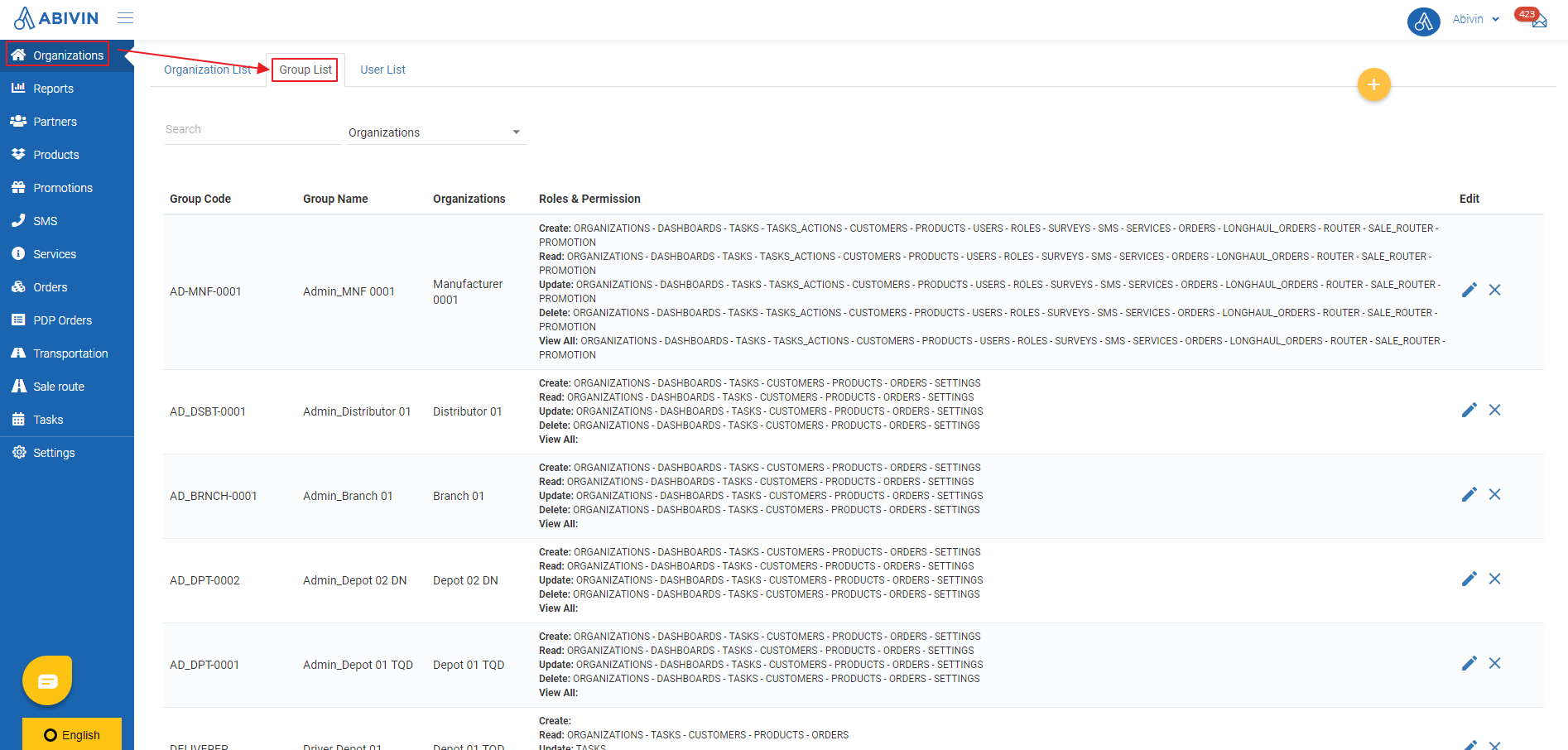
Illustration Image (English)

Illustration Image (Vietnamese)
Create User Groups
- You would notice that after an Organization is created, the Administrator User Group of that Organization will also be automatically created. The Administrator User Groups will have their User Group Code attribute equal to the Organization Code attribute plus the prefix AD-, and the User Group Name attribute equal to the Organization Name plus the prefix Admin_
- For example: A Branch has the Organization Name Branch Hanoi and the Organization Code Branch_Hanoi. The User Group Administrators of that Branch will have the User Group Name Admin_Branch Hanoi and the User Group Code AD-Branch_Hanoi
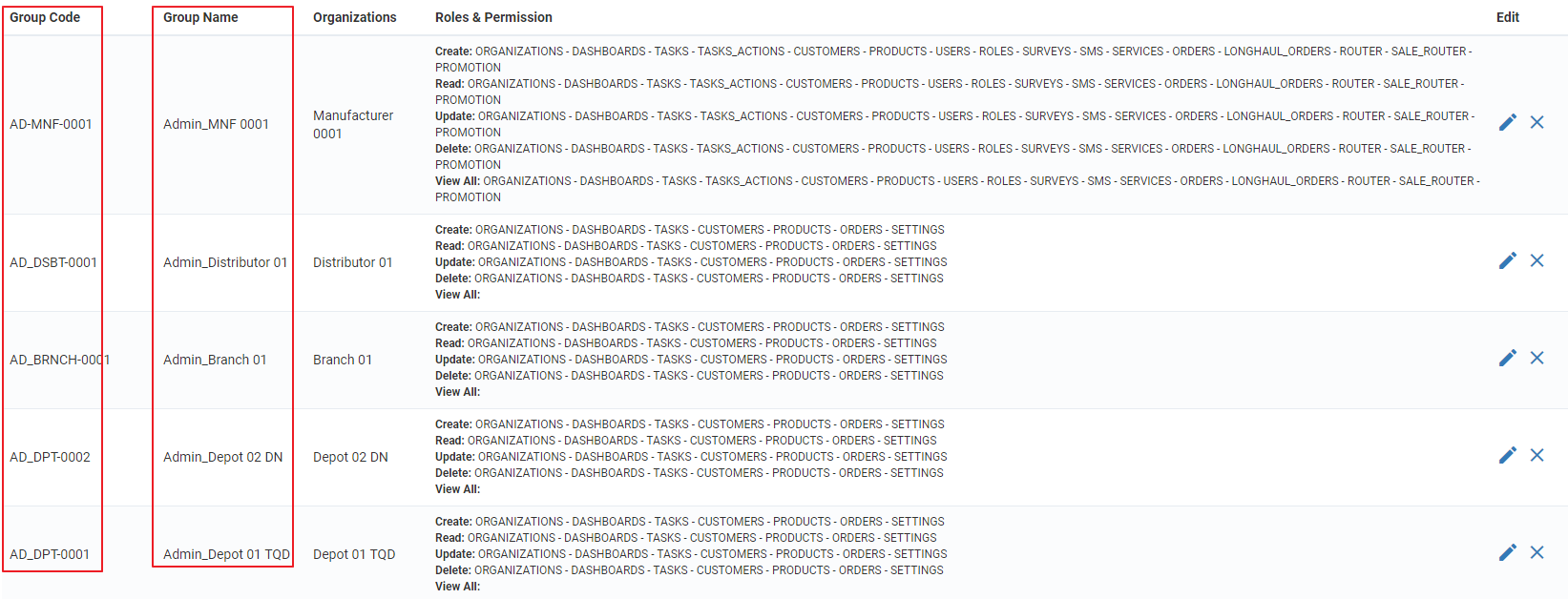
Illustration Image (English)
- If you create the Depot using Web form, the Driver User Group would also be created automatically. They will have the User Group Code DELIVERER

Illustration Image (English)
- Apart from the User Groups that are automatically created, if you wish to create more User Groups, you need to create them manually using Web form. Please refer to the CRUD functions article to know the general steps about creating single objects using Web form
- The User Groups of optional User Types (Salesmen; Consumer) will not be created automatically. You have to create those User Groups manually
User Group Information
- Typically, the information of a User Group will be input in two sections:
- 1 - Basic User Group Information Section. This section specifies the most essential information of the User Group such as User Group Code, User Group Name. Click here for instruction
- 2 - Modules Section. This section specifies the modules that the User Group will have access to and the corresponding CRUD rights over the modules that are allocated to that User Group. Click here for instruction
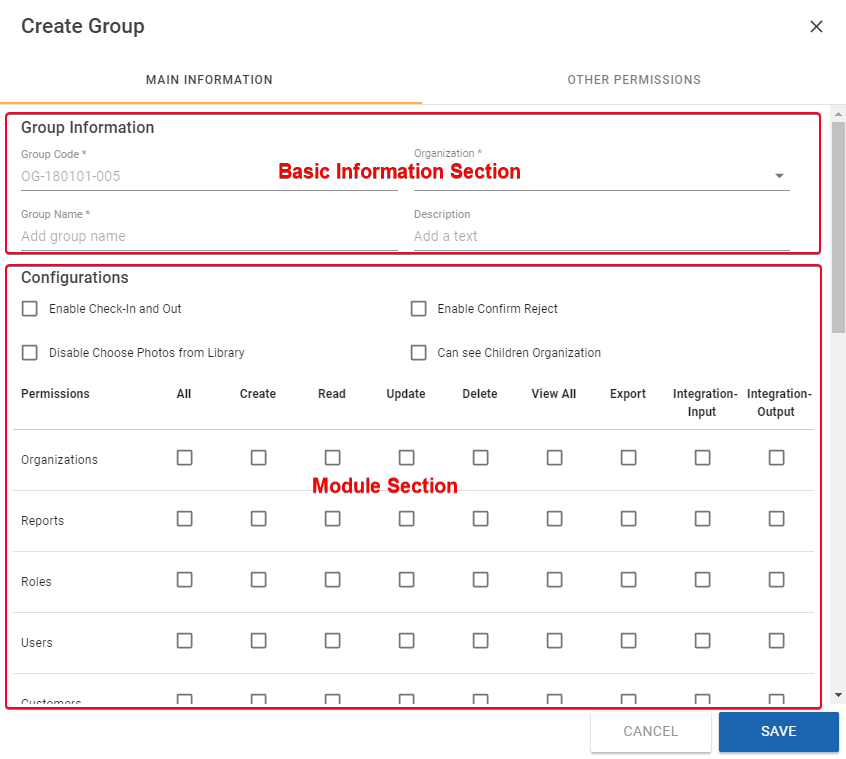
Illustration Image (English)
- Apart from these two sections, there is also the Route Plan Rights Section. This section is intended for the Route Planner User Groups, which specifies the functions the Route Planner Users can perform to the Route Plan. Click here for instruction
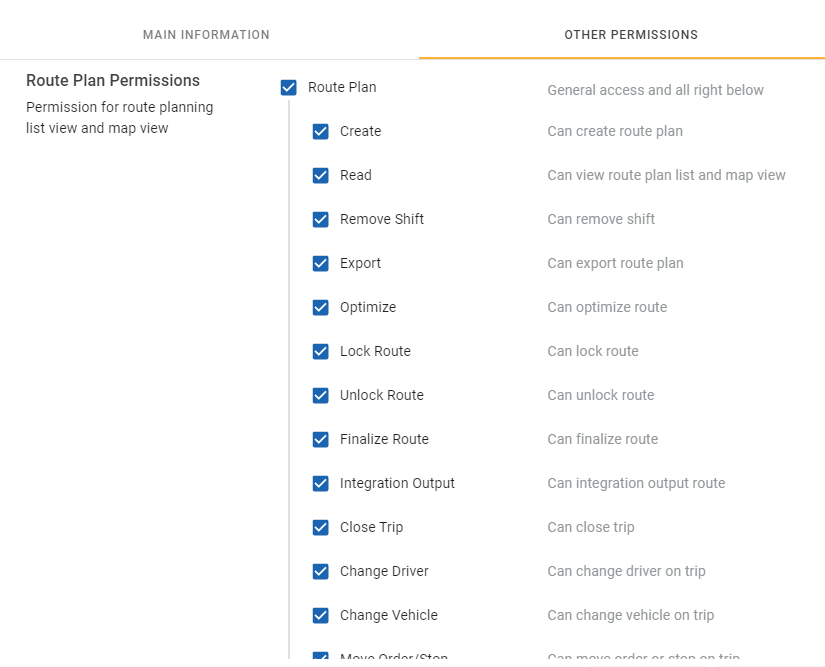
Illustration Image (English)
Basic User Group Information Section
- Below is the list of basic information fields of a User group
Information field | Description & Input |
|---|---|
Organization (Required) | 1. Description: |
Group Code | 1. Description: |
Group Name | 1. Description: |
Description | 1. Description: |
Modules Section
- This section is where you can set up the modules that the User Group can get access to, and the corresponding level of authority over those modules
- Below is the description for each permission
- Note: There are certain permissions that are not yet available for some modules
Module Permission | Permission Description |
|---|---|
Create | Can create the resources of that module |
Read | Can read the resources of that module |
Update | Can update/edit the resources of that module |
Delete | Can delete the resources of that module |
View All | Can view the resources of that module from other Organizations of the same level |
Export | Can export the resources of that module to Excel spreadsheet |
All | All of the above permissions |
Integration-Input | Can pull the resource of that module from external databases (TMS; ERP etc.) into Abivin vRoute database |
Integration-Output | Can push the resource of that module from Abivin vRoute database to external databases (TMS; ERP etc.) |
- Furthermore, in order for the User Group of an upper-level Organization to view the resources of all lower-level Organizations below that upper-level Organization, you need to tick the Can see Children Organization checkbox

Illustration Image (English)
- Below are the essential rights you are recommended to set for each User Group of this model
- Note: The Users who belong to the automatically created Administrator User Group of an Organization will always be able to see all resources of every lower level Organization of that Organization, regardless of whether the Can see Children Organization checkbox is ticked or not. For example, a User who belongs to the automatically created Administrator User Group of a Branch will always be able to see the resources of all Depots under that Branch
Manufacturer Administrator User group
- The table below list the essential modules and permissions you need to enable for the Manufacturer Administrator User Group of this model
Module | Module Permission |
|---|---|
Organizations | All |
Reports | All |
Roles | All |
Users | All |
Customers | All |
Orders | All |
Vehicle | All |
Tasks | All |
Task actions | All |
- Below are the optional permissions which can be enabled depending on your needs:
- If you wish to use the function to retrieve Unplanned (Missing) Orders and Failed Orders from past dates, you also need to tick the Integration - Input checkbox of the Orders module
- If your operation involves using Discounts and Promotions, tick the All checkbox of the Promotion module
- If you wish to use the Convert Tool (Built-in) to convert your Delivery Order files to Abivin vRoute data format, tick the All checkbox of the Mapping Profile module
Depot/Sun Driver User group
Module | Module Permission |
|---|---|
Organizations | Read |
Tasks | Read |
Customers | Read |
Products | Read |
Orders | Read |
- If you want to allow the Drivers to actively rearrange the Stop sequence of their assigned Delivery Route right on their Mobile App (Read more here: Driver (Delivery Men)), then you'll need to navigate to the Other Permissions sub-tab and enable the Move Order/Stop permission
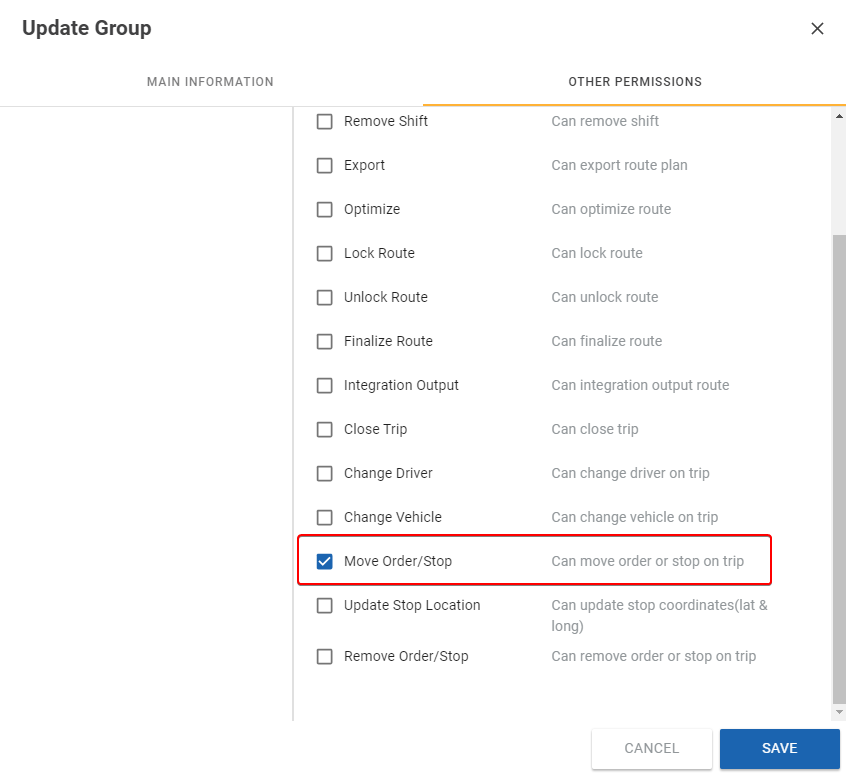
Route Plan Rights Section
- For the Route Planner (Dispatcher) User Groups (Of the Organization Types Manufacturer; Distributor; Branch), there are various functions related to the Route Plan that requires a dedicated setup section apart from the Module section above
- Before going into details, there are some notes:
- 1 - The automatically created Administrator User Group of the Manufacturer will always have full Route Planning permissions regardless of whether the functions in this section are enabled for that User Group or not
- 2 - Some functions in this section will have the same effect as some configurations at some Organization Type (Mostly at the Branch). However, the configurations set up at the Organization will always have priority over the functions described in this section. For example, if you don't enable a function in this section but enable the configuration with the same effect at the Organization, then the Users can still use that function
- 3 - Some functions in this section are only available on either Route Plan (Map View) or Route Plan (List View), not yet available on both modes
- To access the Route Plan Rights setup section, on the Update Group form navigate to the sub-tab Other Permissions
- To enable a function, simply tick its respective checkbox
- To quickly enable all functions, tick the Route Plan checkbox

- Below is the list of all functions related to the Route Plan:
Route Plan Function | Description |
|---|---|
Create | Available for: Map View and List View |
Read | Available for: Map View and List View |
Delete | Available for: Map View and List View |
Export | Available for: Map View and List View |
Optimize | Available for: Map View and List View |
Lock Route | Available for: Map View and List View |
Unlock Route | Available for: Map View and List View |
Finalize Route | Available for: Map View and List View |
Integration Output | Available for: List View |
Close Trip | Available for: List View |
Change Driver | Available for: Map View and List View |
Change Vehicle | Available for: Map View and List View |
Move Order/Stop | Available for: Map View and List View |
Update Stop Location | Available for: Map View |
Remove Order/Stop | Available for: Map View and List View |
- After you have completed creating User groups, let's move on to create Users
Manage Users
Locate User list
- The Users are listed on the Organizations > Users tab
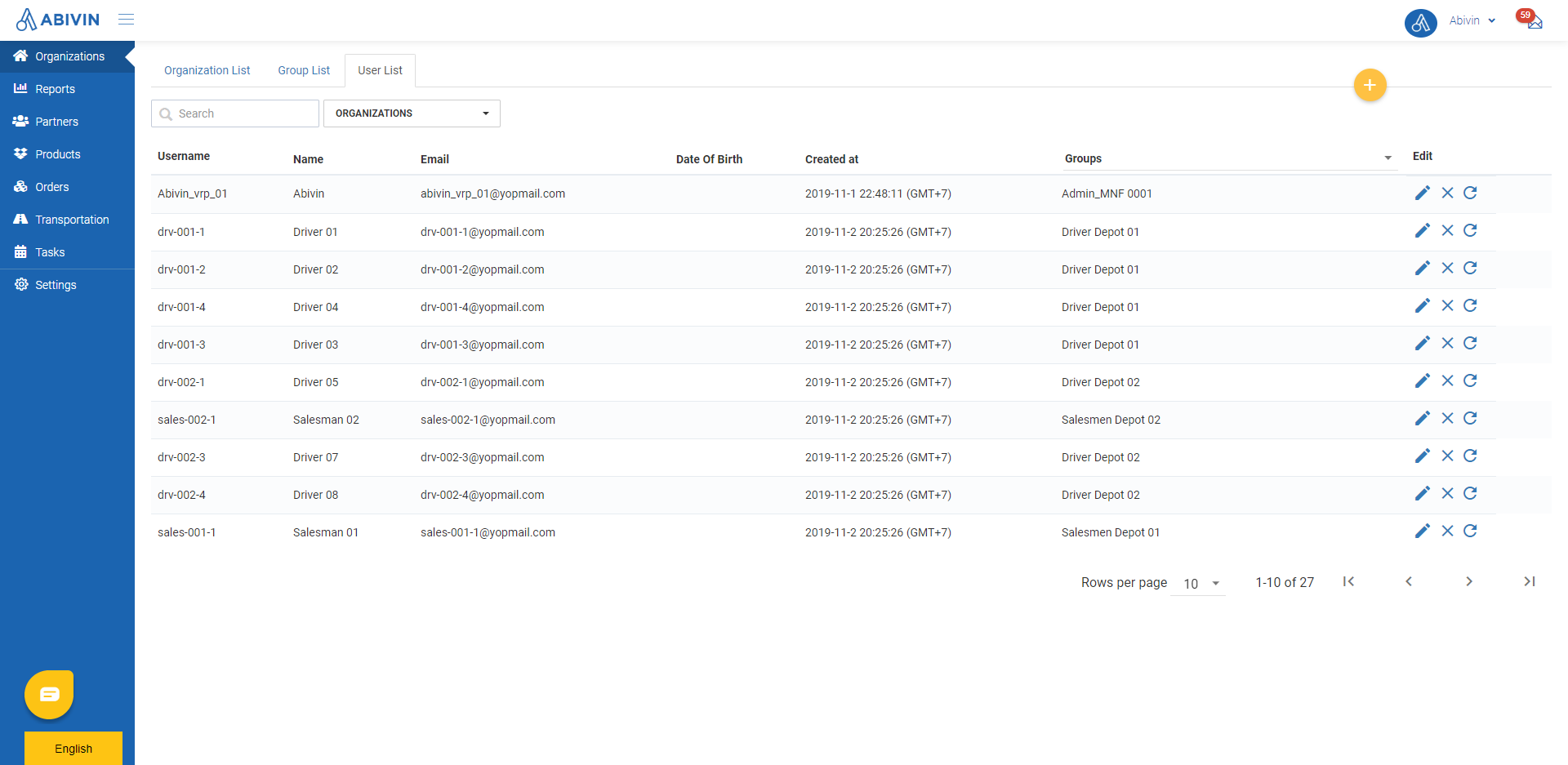
Create Users
- You can create the Users via two methods: Webform and Excel import file
Method 1: Create a single User using the Webform
- When you use the Webform to create a single User, you need to input the basic information fields of that User in the following sequence to ensure no mistake:
- 1 - Organization Name
- 2 - Group
- 3 - Username
- 4 - Password, Re-password
- 5 - Email
- 6 - Phone Number
- 7 - Full Name
- If the User being created is a Driver (Deliveryman), then apart from the basic information above, you also have to fill in some Driver-specific information fields. These information fields are described in the following section: Driver-specific information
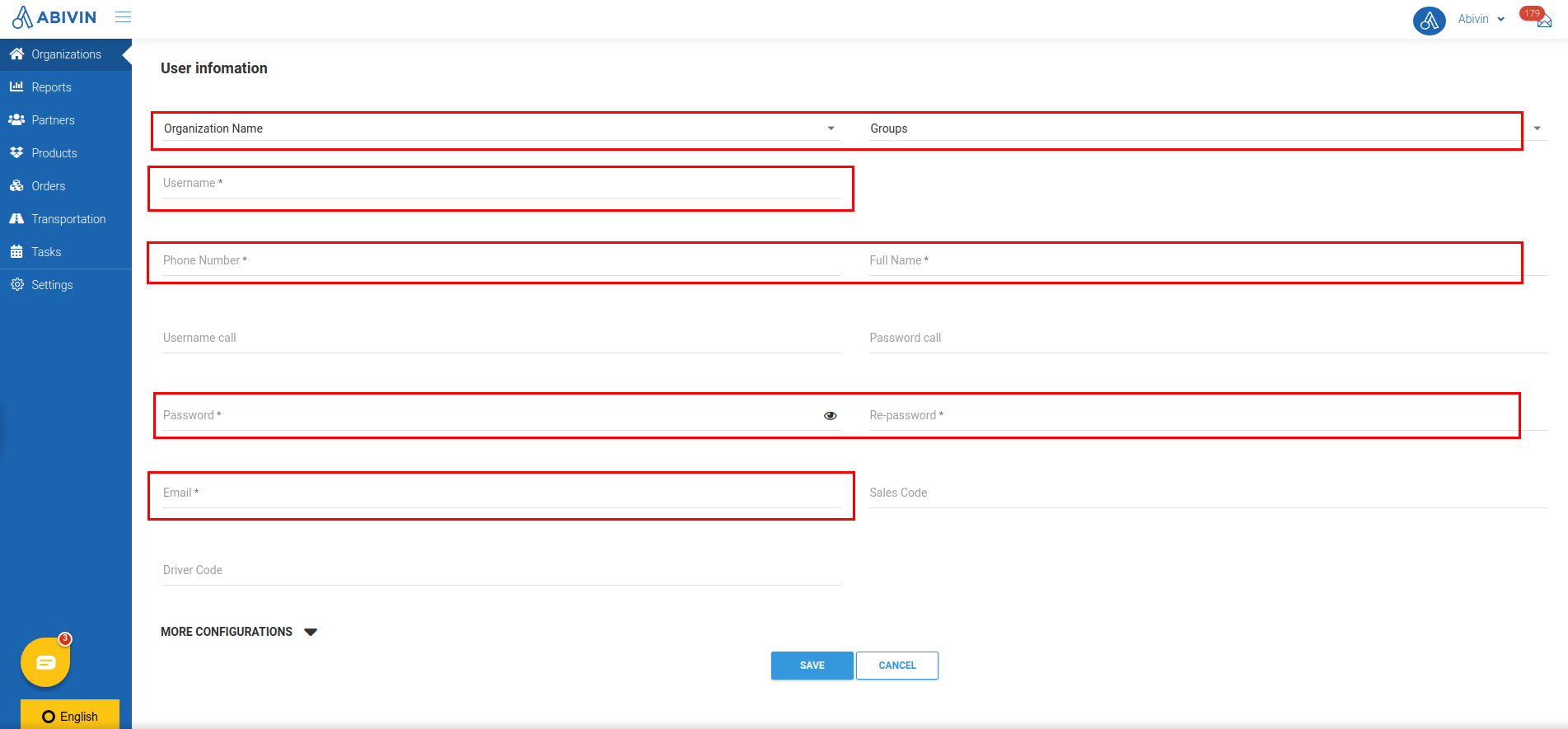
Method 2: Create multiple Users using the Excel file
- You will notice that in the Excel file, there are no Password/Re-password fields like on the Webform. This is because upon uploading the Excel file onto the Web app, the system will automatically generate random passwords for each user and send the password to the Users' email addresses input in the Excel file. The Users have to use those random passwords to login to their accounts for the first time. After logging in, they can change their passwords to new ones (Note that the new passwords must adhere to the Strong Password rules)
How to change password?
- For Web app users, please click on this link
- For Mobile app users, please click on this link
Basic User information
- Below are the basic information of a User
Apart from the information fields mentioned below, other information fields can be left blank during the creation/update processes
Information field | Description & Input |
|---|---|
Organization Name (Webform); Organization Code (Excel File) (Required Field) | 1. Description: |
Groups (Webform); User Group Code (Excel File) | 1. Description: |
Username | 1. Description: |
Password; Re-password | 1. Description: |
Email | 1. Description: |
Phone Number | 1. Description: |
Full Name | 1. Description: |
Driver-specific information
- Apart from the basic information fields above, there will be some additional information fields for Users who are Drivers (Deliverymen). These fields are optional, however
- On the Webform, these information fields will be visible when you click on the MORE CONFIGURATIONS text

Information field | Description & Input |
|---|---|
Vehicle Type (Webform); Type Of Vehicle (Excel File) (Optional Field) | 1. Description: |
Position | 1. Description: |
Driver License Number | 1. Description: |
License Class | 1. Description: |
Medically Cleared | 1. Description: |
Secret | 1. Description: |
sub scription Code | 1. Description: |
sub scription Expiry | 1. Description: |
Change Active Status of Driver Users
- Besides the Organizations > Users tab, the driver users also have a dedicated tab, Transportation > Drivers. On this tab, you can change their Active Status

Illustration Image (English)
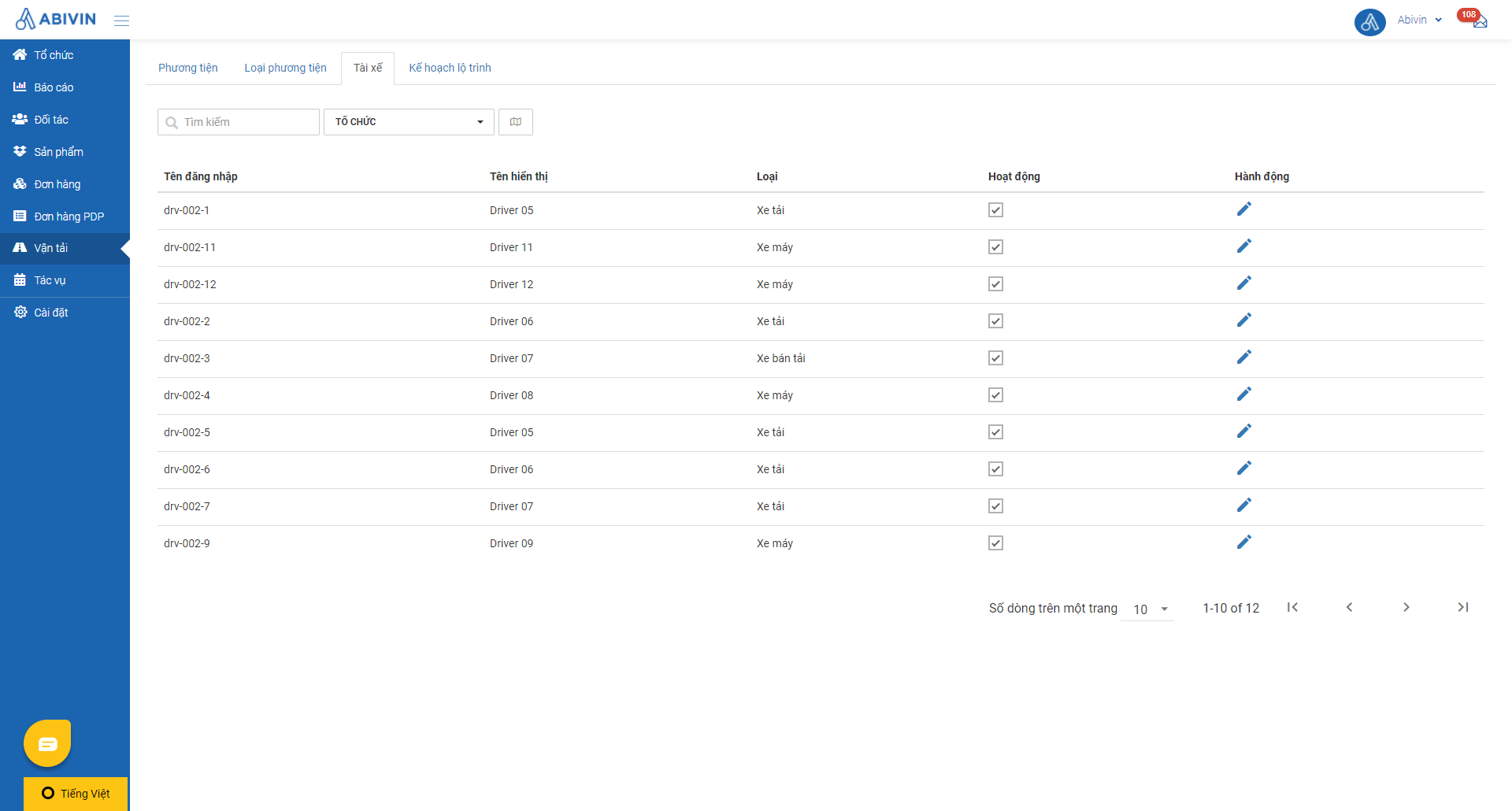
Illustration Image (Vietnamese)
- By default, after being created, all drivers will have the Active Status Active, represented by the icon under the column Active. This means the drivers can be selected to operate the vehicles during the Route Plan optimization process

- To change the active status of a driver, click on that icon. When that icon turns to , that means the Active Status of the driver has been switched to Inactive, which means that driver will not appear anymore in the Route Plan optimization process, unless prior to this you have locked a Delivery Shift with that driver
Beginner's Guide
After creating an organizational chart (you can see the tutorial for beginners here), you can proceed to the next step in the Route Optimization Process: Creating users. In this tutorial, we will determine users as drivers.
Create a User Group
-
Below are the simple steps on how to create a Driver user group using Web form:
-
Step 1: Navigate to Organizations > User Group tab.
-
Step 2: Click on the symbol Create (the symbol).

- Step 3: Input information to complete the Group Information section. There are 3 required fields:
- Group Code: Input the following value: SAMPLE-DELIVERER
- Organization: The organization type must be Depot/Sun: Sample Depot
- Group Name: Input the name of the Driver user group: Sample Deliverers
- Example:
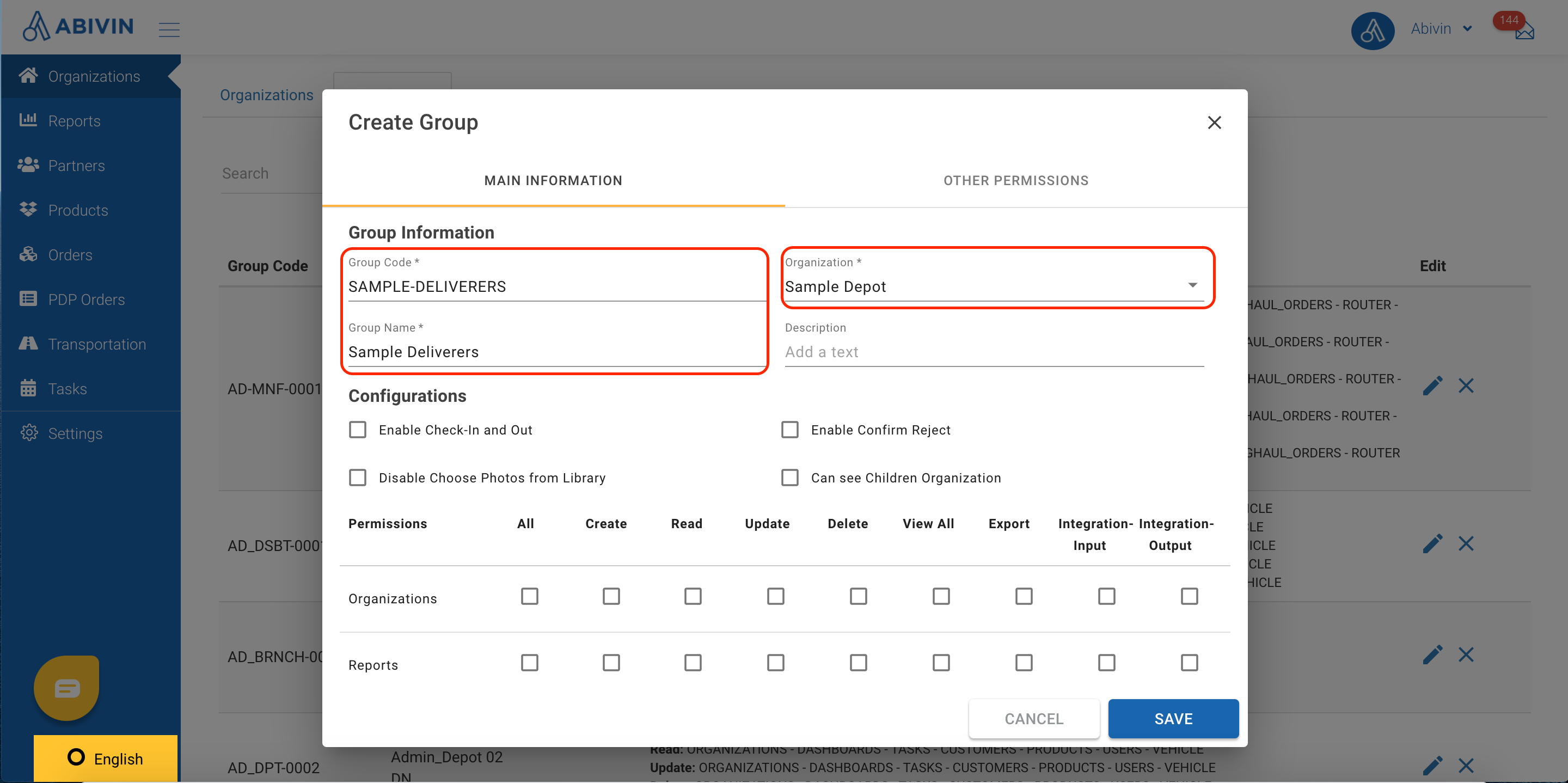
- Step 4: In the Configurations section, set up the modules that the Driver User Group can get access to, and the corresponding level of authority over those modules by ticking the boxes:
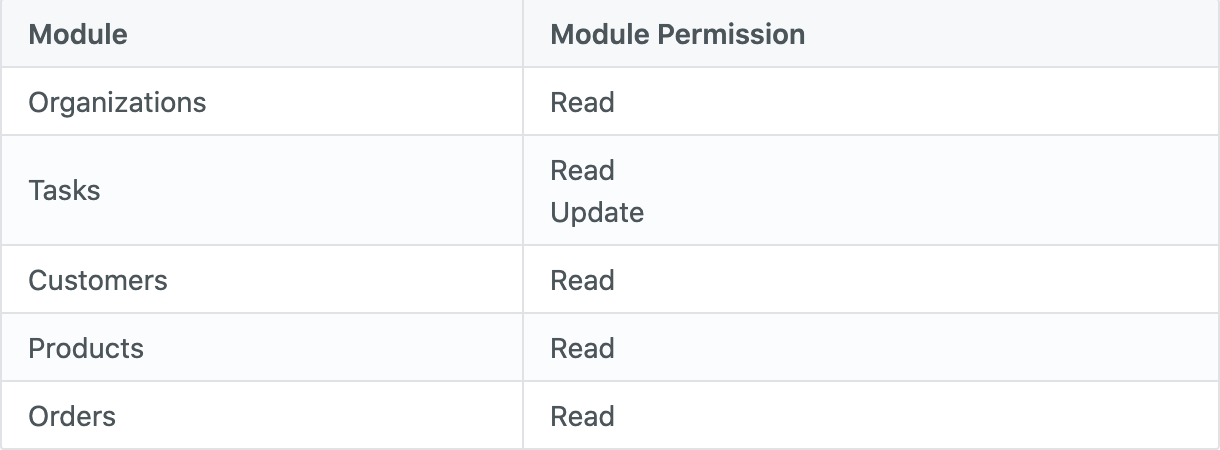
- Step 5: Click SAVE
- Beside Web form, Excel files can be used to create a Driver user group. Here are the steps to import an Excel file into the system:
- Step 1: Navigate to Organizations > User Group tab.
- Step 2: Click on the symbol Import.
- Step 3: Choose the Excel you want to import by dropping it to the area or clicking the area.
- Note: The chosen file must be in the right format and contain required fields (Group Code, Organization, Group Name). You can also download a sample with a correct format provided by us. To do this, click DOWNLOAD SAMPLE. Then you can paste your data onto the sample file.
Create a User
Next, here are the steps you should follow to create a user (driver)
- Step 1: Navigate to Organizations > Users tab.
- Step 2: Click on the symbol Create (the symbol).
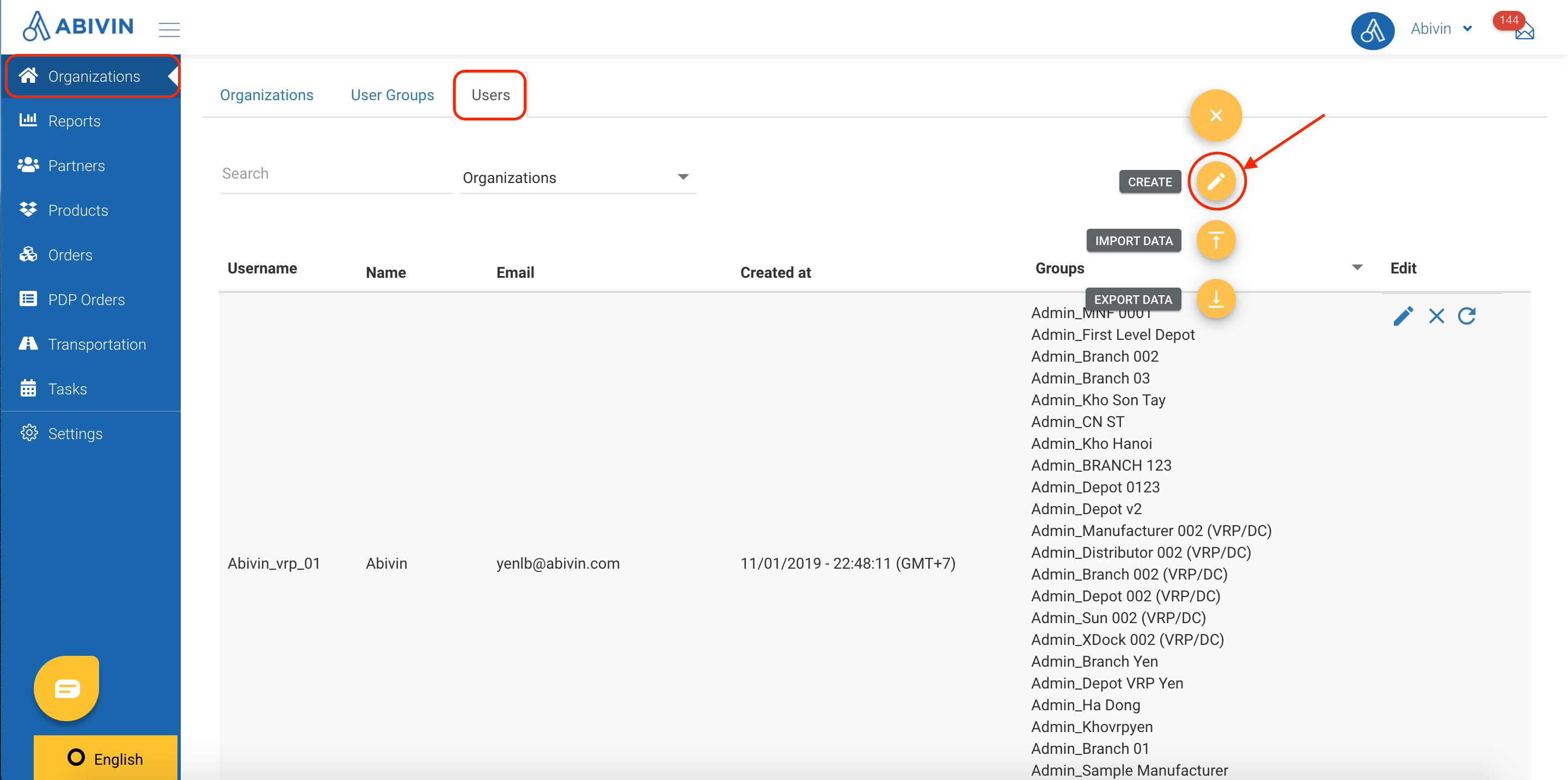
- Step 3: Fill in information to complete the User information section. These are the required fields:
- Organization Name: Input the organization in which the user being created belongs: Sample Depot
- Username: Input the username the driver will use to login to the Web app/Mobile app
- Phone Number: Input the phone number of the driver being created
- Full Name: Input the full name of the driver being created
- Password/Re-password: Input the password the driver will use to login to Web app/Mobile app. The password must follow password rules
- E-mail: Input the e-mail address of the driver being created. After being created, each new user will receive a email attached with a random password. The user must use that password to log in their account on the first time. After successfully logging in, they can freely change the password as instructed in the following article: Change login password
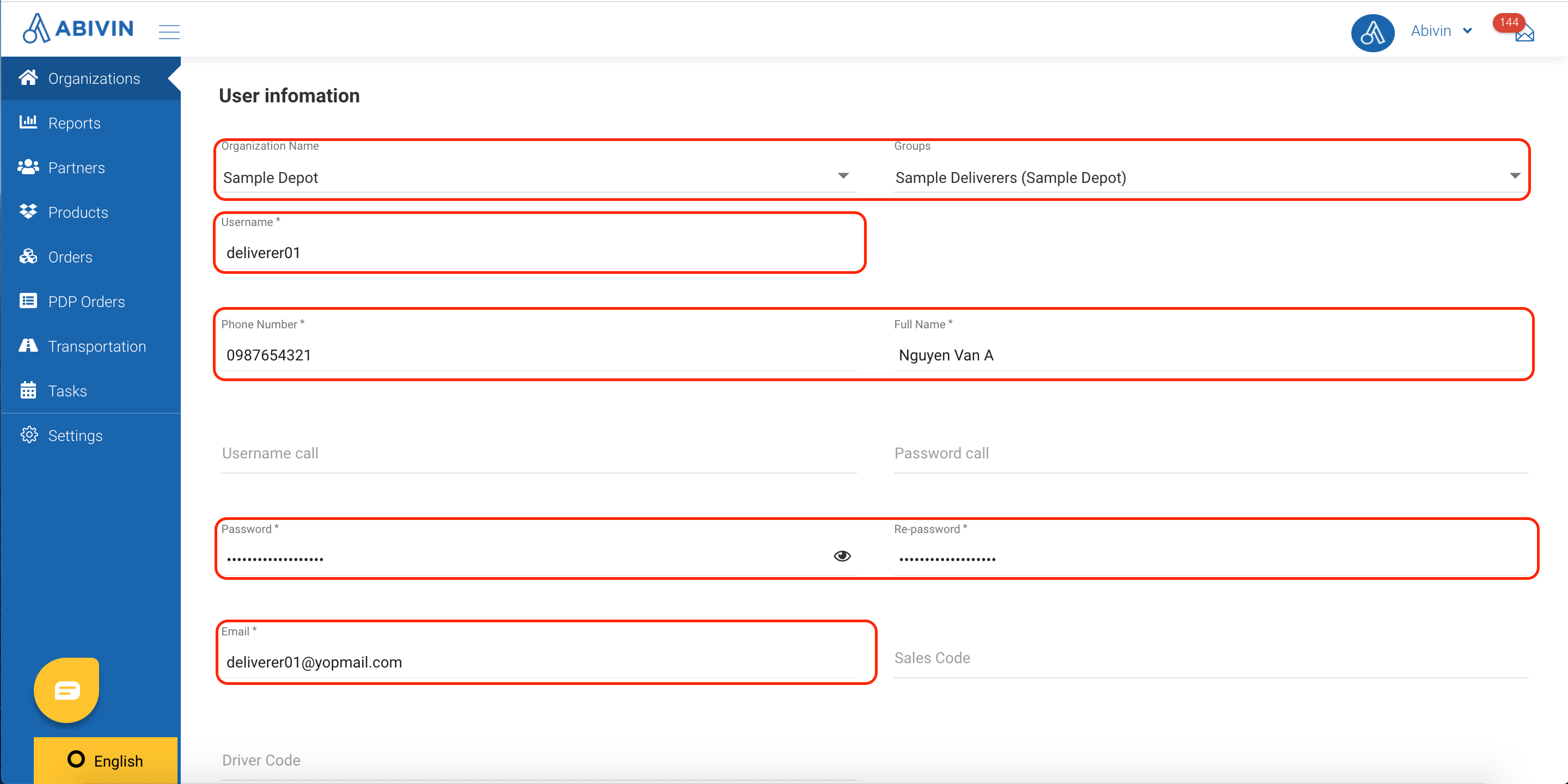
- Vehicle: Click MORE CONFIGURATIONS:fa-caret-down: for the Vehicle field to be shown, then click on vehicle assigned to the driver.

- Step 4: Click SAVE
Updated about 1 month ago
